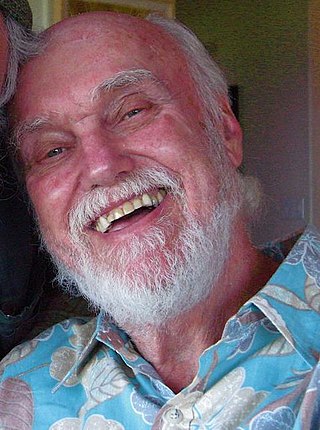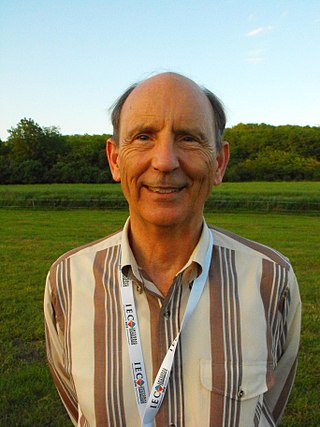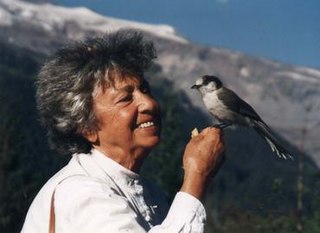
Lysergic acid diethylamide, commonly known as LSD, also known colloquially as acid, is a potent psychedelic drug. Effects typically include intensified thoughts, emotions, and sensory perception. At sufficiently high dosages LSD manifests primarily mental, visual, as well as auditory, hallucinations. Dilated pupils, increased blood pressure, and increased body temperature are typical. Effects typically begin within half an hour and can last for up to 20 hours. LSD is also capable of causing mystical experiences and ego dissolution. It is used mainly as a recreational drug or for spiritual reasons. LSD is both the prototypical psychedelic and one of the "classical" psychedelics, being the psychedelics with the greatest scientific and cultural significance. LSD is typically either swallowed or held under the tongue. It is most often sold on blotter paper and less commonly as tablets, in a watery solution or in gelatin squares called panes.

Timothy Francis Leary was an American psychologist and author known for his strong advocacy of psychedelic drugs. Evaluations of Leary are polarized, ranging from bold oracle to publicity hound. He was "a hero of American consciousness", according to Allen Ginsberg, and Tom Robbins called him a "brave neuronaut".

Psychedelia usually refers to a style or aesthetic that is resembled in the psychedelic subculture of the 1960s and the psychedelic experience produced by certain psychoactive substances. This includes psychedelic art, psychedelic music and style of dress during that era. This was primarily generated by people who used psychedelic drugs such as LSD, mescaline and psilocybin and also non-users who were participants and aficionados of this subculture. Psychedelic art and music typically recreate or reflect the experience of altered consciousness. Psychedelic art uses highly distorted, surreal visuals, bright colors and full spectrums and animation to evoke, convey, or enhance the psychedelic experience. Psychedelic music uses distorted electric guitar, Indian music elements such as the sitar, tabla, electronic effects, sound effects and reverb, and elaborate studio effects, such as playing tapes backwards or panning the music from one side to another.
The Human Potential Movement (HPM) arose out of the counterculture of the 1960s and formed around the concept of an extraordinary potential that its advocates believed to lie largely untapped in all people. The movement takes as its premise the belief that through the development of their "human potential", people can experience a life of happiness, creativity, and fulfillment, and that such people will direct their actions within society toward assisting others to release their potential. Adherents believe that the collective effect of individuals cultivating their own potential will be positive change in society at large.

Daniel Goleman is an author, psychologist, and science journalist. For twelve years, he wrote for The New York Times, reporting on the brain and behavioral sciences. His 1995 book Emotional Intelligence was on The New York Times Best Seller list for a year and a half, a bestseller in many countries, and is in print worldwide in 40 languages. Apart from his books on emotional intelligence, Goleman has written books on topics including self-deception, creativity, transparency, meditation, social and emotional learning, ecoliteracy and the ecological crisis, and the Dalai Lama’s vision for the future.

Ram Dass, also known as Baba Ram Dass, was an American spiritual teacher, guru of modern yoga, psychologist, and writer. His best-selling 1971 book Be Here Now, which has been described by multiple reviewers as "seminal", helped popularize Eastern spirituality and yoga in the West. He authored or co-authored twelve more books on spirituality over the next four decades, including Grist for the Mill (1977), How Can I Help? (1985), and Polishing the Mirror (2013).
Humphry Fortescue Osmond was an English psychiatrist who expatriated to Canada, then moved to work in the United States. He is known for inventing the word psychedelic and for his research into interesting and useful applications for psychedelic drugs. Osmond also explored aspects of the psychology of social environments, in particular how they influenced welfare or recovery in mental institutions.
Julia B. Cameron is an American teacher, author, artist, poet, playwright, novelist, filmmaker, pigeon fancier, composer, and journalist. She is best known for her book The Artist's Way (1992). She also has written many other non-fiction works, short stories, and essays, as well as novels, plays, musicals, and screenplays.
Andrew Harvey is a British author, religious scholar and teacher of mystic traditions, known primarily for his popular nonfiction books on spiritual or mystical themes, beginning with his 1983 A Journey in Ladakh. He is the author of over 30 books, including, The Hope, A Guide to Sacred Activism, The Direct Path, the critically acclaimed Way of Passion: A Celebration of Rumi, The Return of the Mother and Son of Man. He was the subject of the 1993 BBC documentary "The Making of a Modern Mystic" and is the founder of the Sacred Activism movement.
Betty Edwards is an American art teacher and author best known for her 1979 book Drawing on the Right Side of the Brain. She taught and did research at the California State University, Long Beach, until she retired in the late 1990s. While there, she founded the Center for the Educational Applications of Brain Hemisphere Research.
A psychedelic experience is a temporary altered state of consciousness induced by the consumption of a psychedelic substance. For example, an acid trip is a psychedelic experience brought on by the use of LSD, while a mushroom trip is a psychedelic experience brought on by the use of psilocybin. Psychedelic experiences feature alterations in normal perception such as visual distortions and a subjective loss of self-identity, sometimes interpreted as mystical experiences. Psychedelic experiences lack predictability, as they can range from being highly pleasurable to frightening. The outcome of a psychedelic experience is heavily influenced by the person's mood, personality, expectations, and environment.

Ralph Metzner was a German-born American psychologist, writer and researcher, who participated in psychedelic research at Harvard University in the early 1960s with Timothy Leary and Richard Alpert. Metzner was a psychotherapist, and Professor Emeritus of psychology at the California Institute of Integral Studies in San Francisco, where he was formerly the Academic Dean and Academic Vice-president.
Michael Hollingshead (?–1984?) was a British researcher who studied psychedelic drugs, including psilocybin and LSD, at Harvard University in the mid-20th century. He was the father of comedian Vanessa Hollingshead. He evangelized the use of LSD to many notable figures.

Flashbacks: A Personal and Cultural History of an Era is Timothy Leary's autobiography, published in 1983. It was reprinted in 1990 and 1997. The new edition has a foreword by William S. Burroughs, and a new afterword by Leary.

Marilyn Ferguson was an American author, editor and public speaker known for her 1980 book The Aquarian Conspiracy, which is connected with the New Age Movement.

Roger N. Walsh is an Australian professor of Psychiatry, Philosophy and Anthropology at the University of California, Irvine, in the Department of Psychiatry and Human Behavior, within UCI's College of Medicine. Walsh is respected for his views on psychoactive drugs and altered states of consciousness in relation with the religious/spiritual experience, and has been quoted in the media regarding psychology, spirituality, and the medical effects of meditation.
Betty Grover Eisner was an American psychologist known for pioneering the use of LSD and other psychedelic drugs as adjuncts to psychotherapy.
The following is a list of works by Timothy Leary. The majority of Leary's works were put into the public domain by his estate in 2009.
The Spring Grove Experiment is a series of lysergic acid diethylamide (LSD) studies performed from 1963 to 1976 on patients with psychotic illnesses at the Spring Grove Clinic in Catonsville, Maryland. These patients were sponsored by a federal agency called the National Institute of Mental Health to be part of the first study conducted on the effects of psychedelic drugs on people with schizophrenia. Then, the Spring Grove Experiments were adapted to study the effect of LSD and psychotherapy on patients including alcoholics, heroin addicts, neurotics, and terminally-ill cancer patients. The research done was largely conducted by the members of the Research Unit of Spring Grove State Hospital. Significant contributors to the experiments included Walter Pahnke, Albert Kurland, Sanford Unger, Richard Yensen, Stanislav Grof, William Richards, Francesco Di Leo and Oliver Lee McCabe. Later, Spring Grove was rebuilt into the Maryland Psychiatric Research Center, where studies continued to be performed for the advancement of psychiatric research. This study on LSD is the largest study on psychedelic drugs to date.

Nina Graboi was a Holocaust survivor, artist, writer, spiritual seeker, philosopher, and influential figure in the sixties psychedelic movement. After fleeing the Nazis in Europe and spending three months in a detention camp in North Africa, she and her husband came to America as refugees. As a close friend and colleague of Timothy Leary's and Richard Alpert's, she was co-founder and director of the League for Spiritual Discovery's New York Center during the psychedelic era. The center was the first LSD-based meditation center in Manhattan. She also worked closely with Jean Houston, Abraham Maslow, Stanley Krippner, and Alan Watts.










